King's Cup - 1931
-
-King's Cup - 1931
-
-The Aviators
The Aviators
-
Atcherley, David Francis William
Flt-Lt David Francis William Atcherley DFC DSO Twin brother of Richard, so you don't need another photo. "Licences which he holds are (according to himself) motor (endorsed), gun, dog, and 'A'."
He and his brother became "a legend in the RAF".
d. 8 Jun 1952
-
Bailey, Mary
Hon. Lady Mary Bailey
Royal Aero Club Certificate No. 8067 (26 Jan 1927) 1927, aged 37
1927, aged 37
1930, aged 40
The Hon. Mary Westenra, b. 1 December 1890 in London but brought up mainly in County Monaghan, Ireland.
Her family's home was Rossmore Castle, which was a grand affair built in the 1820s, with turrets, a vast drawing room and servants' quarters, not to mention about 20 cottages on the estate:
 www.monaghan.ie/museum
www.monaghan.ie/museumHere she is, with her brother Willie, and parents (Mittie and Derry) on a set of steps by the house, in 1913:
 Throttle Full Open
Throttle Full OpenI visited County Monaghan in 2014 and asked in the local museum if they knew where the house was. 'Oh yes' they said, 'but it was demolished forty years ago'. It seems that it became severely infested with dry rot in the 1940s, was abandoned and, indeed, demolished in 1975.
Anyway, here's all that's left of it now:


Mary married South African mining magnate and white suprematist politician Sir Abe Bailey in September 1911 (so, she was 21, he was nearly 47; his first wife had died in 1902 and he already had two children). They then had five more children - 2 boys and 3 girls.
She learnt to fly at the London Aeroplane Club in 1926. She was the first woman to fly across the Irish Sea 'by the long route' from Chester to Dublin, the following August.
The following March (1928) she began a solo tour to Cape Town, via Malta and then Cairo. Here, her plane was locked away by order of the Governor-General of the Sudan to prevent her from continuing alone, so she contacted Dick Bentley (who had flown to the Cape a few weeks before) to escort her in his own aeroplane over the "dangerous area of the southern Sudan". She then crashed in Tanganyika, writing off her aeroplane (she said it was her fault), but Abe made arrangements for a replacement Moth to be delivered from Pretoria and she continued, despite having 'flu. Abe was there to meet her when she arrived at the end of April.
The return journey was made via the western 'French' route - the Belgian Congo, Angola and the French Congo. She finally arrived back at Croydon on 16 January, 1929, 10 months after she left. It was "undoubtedly one of the finest performances ever put up by a woman pilot."
Lady Bailey was "so modest, so vague and so charming", and was "surprised that anyone should make a fuss about her journey".
A Director of National Flying Services in 1929, (with Frederick Guest, Colonel the Master of Sempill, Alan Cobham, etc); she was also awarded the Brittania Trophy by the Royal Aero Club, and then made a Dame of the British Empire in 1930 for "services to aviation".
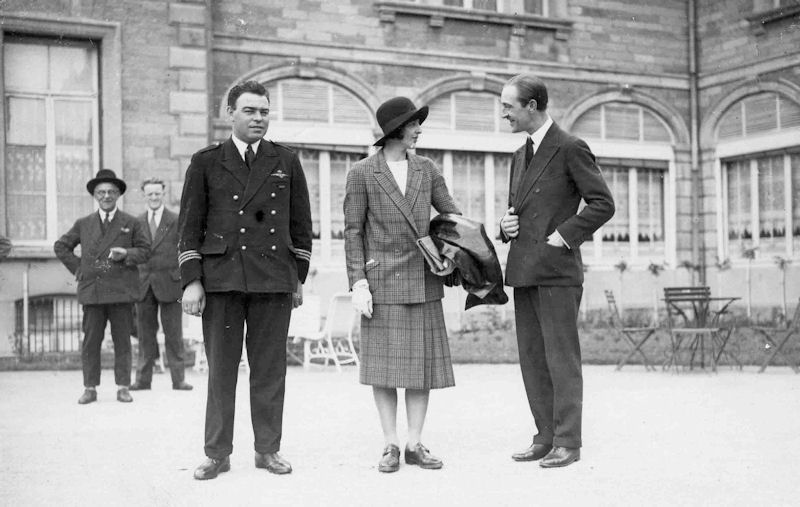
At the Chateau d'Ardennes in 1930

She was a guest at Amelia Earhart's reception at the Royal Aero Club in May 1932.
In early 1933 she gave everyone a scare by disappearing for several days on another solo flight to Cape Town; thankfully, she had only got lost, run low on fuel and landed safely in the Sahara. [Bert Hinkler, who disappeared at about the same time, was killed in the Alps]. She then flew back to England and almost immediately went down with a bout of typhoid, but recovered in time to compete in the King's Cup later in the year.

After that, she concentrated on looking after their horses, giving and attending loads more balls and receptions, and marrying off their many children.
When Abe died in 1940, she settled near Cape Town (still keeping a house in Rutland) and died there 29th August 1960 aged 69.
Lady Mary's aeroplanes were:
a 1926 DH.60 Moth (G-EBPU),
a 1927 DH.60X Moth (G-EBSF, the one she crashed in Tanganyika),
the replacement DH.60X Moth (G-EBTG, which Abe bought in Nairobi);
a 1928 DH.60G Gipsy Moth (G-AABN);
a 1929 DH.60G Gipsy Moth (G-AAEE) and
a 1930 DH.80A Puss Moth, G-AAYA.
-
Balfour, Lionel Maxwell Joachim
Mr Lionel Maxwell Joachim Balfour
 photo: 1930, aged 25
photo: 1930, aged 25b. 11 Dec 1905.
Ian Long kindly tells me that " Christopher Balfour, Lionel's son, published a lovely book about him in 1999 called "Spithead Express: The Pre-War Island Air Ferry and Post-War Plans" (Magna Press, ISBN 0 95194423 8 7), copies of which can be found on Ebay from time to time.""Lionel gained a degree in engineering and served his apprenticeship at English Electric. He was left with a substantial amount of money following the death of his mother in 1928. He owned Puss Moth G-ABIY, which his sister Rachel had in fact won in a raffle. He housed it at Hanworth with his Moth G-ABJH.He was aware of the need for an air link between Portsmouth and Ryde on the Isle of Wight and put a considerable amount of money into Wight Aviation, of which he was a director, in 1931. A Klemm G-ABJX and a Spartan 3-seater G-ABLJ were used by the firm. In 1932, the company attracted Francis 'Lux' Luxmoore who also became a director and the name was changed to Portsmouth, Southsea & Isle of Wight Aviation (P.S.&I.O.W.A.). The venture proved to be a great success, with their pale blue, buff and silver livery. Airspeed were keen to use P.S.&I.O.W.A. to show off their products and the air ferry used 6 Couriers, 1 Ferry and 1 Envoy. The air ferry were also keen Monospar customers."Another director of PS&IOWA was Sir Charles Rose (q.v.).He married Lady Myrtle, 24-year old third daughter of the Admiral of the Fleet Lord Jellicoe, in 1932, and here they are after the nuptuals:

She died after an operation on 10 November, 1945 though, and he married twice more.
"All of the air ferry aircraft were impressed into service when WWII began and so the company's engineers began to carry out contract work for their neighbours, Airspeed. By the time the war began the company had already manufactured 31 pairs of Oxford wings for Airspeed. Balfour's company undertook a complete rebuild of an Oxford and thus became a part of the Nuffield repair organisation. By the time the war ended they had repaired or modified over 1,000 Oxfords. Keen to restart the air ferry using De Havilland Dragon Rapides, Balfour managed to get a severely restricted charter service going but it ceased by the end of 1947. Now presented as a fully fledged engineering company it looked to others sources of revenue. P.S.&I.O.W.A. became Portsmouth Aviation and designed and built the Portsmouth Aerocar G-AGTG. It was displayed at the 1947 and 1948 S.B.A.C. air shows. Despite great interest in the Aerocar at home and in India, the venture was stalled. During the latter half of the 20th century the company were constructing military ordnance carriers and loaders.
Lionel Balfour died in 1973."
-
Bradbury, J
Flt-Lt J Bradbury  1931
1931 Transferred from the Army to the R.F.C. in 1917; 1919-20 R.A.F. in Egypt, and from 1921-25 in India, seeing active service in Waziristan in 1923 and 1925.
A test pilot at Martleslham from 1926.
-
Bramson, Mogens Louis
Mr Mogens Louis Bramson 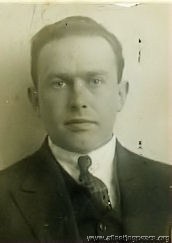
photo: 1923, aged 28
from Copenhagen. Flew with Major Savage's 'Sky Writers' at Hendon in the 1920s - borrowed an aeroplane to write a certain lady's name in the sky. She, of course, later became his wife.
And, would you believe it, he was in charge of the 'Scandinavian Sky-Writing Expedition' in 1923-24.
-
Brown, Winifred Sawley
Miss Winifred Sawley Brown
Royal Aero Club Certificate No. 8091 (6 Apr 1927)
 photo: 1927, aged 28
photo: 1927, aged 28 .jpg)
b. 26 November 1899 in Brooklands, Cheshire; her father was director of a firm of butchers.
She said she learnt to roll her own cigarettes at the age of five; expelled from school at age fourteen (for writing 'the headmistress can go to hell' on the toilet wall), she made her first flight in 1919 from Blackpool sands.
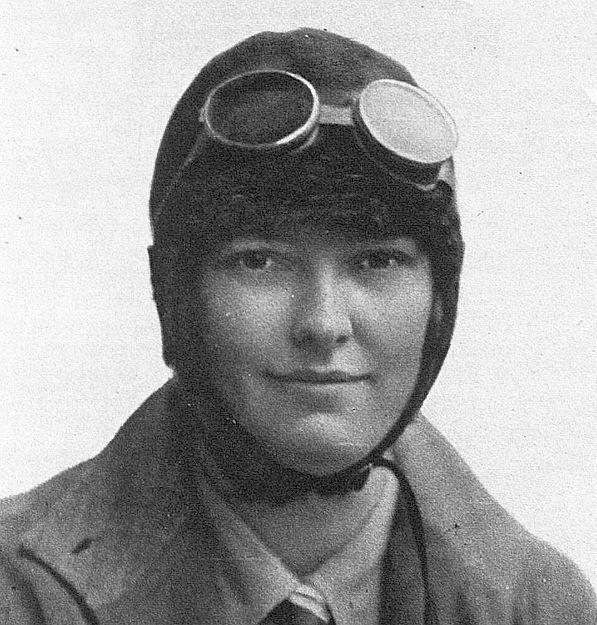 "A Well-known English Pilot" - The Sketch, 1929
"A Well-known English Pilot" - The Sketch, 1929First woman to win the King’s Cup (in 1930); well known in Lancashire as a hockey player who kept goal for the county and toured Australia with an English team; also a pretty good golfer, sailor and tennis player.
To see her being thoroughly embarrassed by her reception back at the Lancs Aero Club after winning the King's Cup, and to hear her say “Thank you for this welcome, it’s awfully good of you and I’m awfully happy to be back again in Lancashire, at the aerodrome where Captain Brown taught me to fly…. I’m delighted to have won the race and, well, thank you all very very much, I can’t say any more”, see here
.jpg)
Her son, Tony, b. 11 December 1940 in Angelsey, is "loved and remembered by millions as slippery Adam Chance in Crossroads".
She owned:
the 1928 Avro 594 Avian III, G-EBVZ - which her father bought for £500 - in which she won the King's Cup in 1930, then
a 1930 Avro 616 Sports Avian, G-ABED.
'Win' died in July 1984 in Hove, Sussex.
And you can now get a proper biography, entitled "WINIFRED BROWN: Britain's Adventure Girl No. 1", written by King's Lynn's most famous living author, Geoff Meggitt.
See www.pitchpole.co.uk for details!
b 26 November 1899 in Brooklands, Cheshire; her father was director of a firm of butchers.
Learnt to fly in 1926, but in 1928 was the pilot in a horrific accident when she was duped into a publicity stunt by Walter Browning, the 'Dancing Airman', who told her a film had to be delivered urgently, and persuaded to land her Avian in a field. She was surprised to see a crowd of people, realised she wasn't going to stop in time and tried to take off again, but hit the crowd standing near a wall; a 10-year old boy was killed, several persons injured, and "many women fainted". It turned out that the 'urgent film' never existed, just an empty box. She was exonerated of any blame.
First woman to win the King’s Cup, in 1930. She became an instant star across the world, especially in her home city of Salford. Invited to the 1930 Historical Pageant at Buile Hill Park shortly after the race, crowds chanted for a speech to be made. Winifred said “This is really wonderful of you all, I am very glad to belong to Salford” which prompted one audience member to start a sing along of ‘for she’s a jolly good flyer’. The Mayor of Salford congratulated Winifred on behalf of the people, and joked “No man begrudges you your honour and you have put us all back in our place”.
Before the Race, she was "well known in Lancashire as a hockey player who keeps goal for the county and has toured Australia with an English team".
One of the guests of honour at the Ladies Night dinner of the Press Club in December 1930; the chairman reckoned that "Women had forced their way into the columns of the Press, and now they seemed to be on the way to monopolizing them".
She was still an active ice hockey player in 1933, flying herself from Manchester to London to take part in the Sheridan Cup, where she kept goal for the "Queen's Ladies". She was also a pretty good golfer; she and her partner Mrs Brooks got to the last 8 of the Ladies' Northern Foursomes at Leeds in 1938.
Later sailed from North Wales to Spitsbergen in her 45-foot yawl Perula. During WWII, Chief Coxswain in the Marine Department of Saunders Roe.
In 1940 she gave birth to a son, Anthony, after it was revealed she had "secretly married her long time adventure companion Ron Adams" (although I'm not sure what was so secret about it).

She attended the 1950 King's Cup Race, but was "horrified ... I thought sadly of Bert Hinkler, Cobham, Barnard, Hubert Broad and Wally Hope."
'Win' died in July 1984 in Hove, Sussex.
Winifred Brown was born [26 November] 1899 in Brooklands, Cheshire. She moved to Salford at an early age and went on to attend ‘Bella Vista’, Broughton High School for Girls. Winifred’s father, Mr Sawley Brown, was director of Messrs. James S. Brown & Sons, a firm of butchers.
Winifred was a natural sportswoman, and achieved great success in flying when she became the first woman to join the Lancashire Aero Club in 1926 and the first woman in the region to qualify for a pilot’s licence in April 1927. By March 1928 Winifred was recruited to the rank of a private owner member, and that same year she won the club’s Rodman Trophy.
By the 1930 King’s Cup Air Race, a 750mile race around England, Winifred Brown was an experienced pilot, although she had never flown such a long distance. In the pre-race articles that appeared in Flight magazine, on June 13 1930,Winifred’s entry was not taken seriously, mentioned with six other pilots of the ‘fairer sex’ only briefly. Winifred flew an Avro Avian with a Cirrus III engine with her co-pilot, and later husband, John Ron Adams. The Air Race was full of excitement, after starting the race at Hanworth, London. By the time she reached Barton Aerodrome, Winifred was in third position and the large crowds roared with excitement. The final finish was at Newcastle, by which time she’d run away with the lead. There was a dramatic finish when Winifred spotted a large aircraft behind them. Believing it to be a competitor and determined not to be beaten to the finish line, the Avian was pushed to speeds of 160 miles per hour! Afterwards a mechanic told the Salford Reporter that this speed ‘was courting disaster’. By pushing her Avian to the limits Winifred beat her male contemporaries, including Flight Lieutenant Waghorn, winner of the prestigious Schneider Cup.
As the first woman to win the King’s Cup, Winifred became an instant star across the world, especially in her home city of Salford. Invited to the 1930 Historical Pageant at Buile Hill Park shortly after the race, crowds chanted for a speech to be made. Winifred said “This is really wonderful of you all, I am very glad to belong to Salford” which prompted one audience member to start a sing along of ‘for she’s a jolly good flyer’. The Mayor of Salford, Samuel Finburgh, congratulated Winifred on behalf of the people, and joked “No man begrudges you your honour and you have put us all back in our place”(Salford Reporter 11 July 1930).
Winifred’s later adventures in the 1930s went beyond Britain, this time sailing rather than flying from North Wales to Spitsbergen in her 45-foot yawl Perula. During the Second World War, Winifred worked as Chief Coxswain in the Marine Department of Saunders Roe, the flying boat constructors in Beaumaris. Winifred worked with a fleet of R.A.F. craft with all-male crews, she met Catalinas from Bermuda, landed and embarked crews and towed aircraft.
In 1940 she gave birth to a son, Anthony Sawley Adams, after it was revealed she had secretly married her long time adventure companion Ron Adams.
With thanks to John B. Coxon and Tony Adams
In 1950, Winnie wrote this lovely article for 'Flight':
POST-WAR AIR RACING - is Something Missing?
A Pre-war Winner Asks Some Pertinent Questions
By WINIFRED BROWN
As something "rather different" in post-war air races, the Daily Express "International South Coast Race" on September 16th seems likely to be watched with interest, especially by "the forgotten pioneers of long ago" - in which category a South African magazine recently included me!
For some time we have been asking ourselves " What has gone wrong - air racing or we old pilots?" Has the sport really lost its thrill and popularity, or have we merely become the club bores who stand at a bar counter and say, between beers, "Things aren't what they were"?
I have been thinking about these questions for several weeks - ever since, in fact, I set off, in excited anticipation and an Austin Seven - to see this year's King's Cup Race. The Wolverhampton Aero Club had very kindly invited me - "Just to show them you are still in the land of the living, Win?" chuckled John Bill over the telephone, for the previous year the B.B.C. had coupled my name with the type of wings that go with a harp! It was 20 years since I had won the King's Cup and 19 years since I have even seen an air race. I had a shock coming to me!
When asked if I were flying, I laughed and replied ungrammatically, "What, me! I'm used to 105 m.p.h.,not 501." And as my little car proceeded at a sedate 40m.p.h. my mind went back 20 years. Who would be there? Tommy Rose, Jimmy Jeffs, Robin Cazalet, "Lamps"? What fun it would be to see them all again!
On arrival at the Star and Garter I rushed to look at the hotel register... I didn't recognize a single name! They must still be in the bar... we had always lingered... they would come later; so, casting respectability to the wind, I ignored my married name and wrote " Win Brown and son."
That night there was a R.A.F.A. dance - to meet the "famous pilots"! The dancing was popular enough, but we were not; when we went on the stage the room practically emptied - the dancers had probably done far more flying than we had!
Still there was a nice bar upstairs, and I talked with interest to the 1950 pilots. "Do you have flying pageants these days?" I asked a young man. For a moment he looked puzzled, then replied "Yes, but we call them 'air rallies'". When I flew in 1930 we had a 750-mile course. Do you like these short circuits? " "Oh yes! It's a better test of flying—none of this navigation stuff enters into it. '
I thought sadly of Bert Hinkler, Cobham, Barnard, Hubert Broad and Wally Hope. That night I went to bed at 11.30 - if there was a party I didn't find it!
Next day I got to the airfield early. I looked and blinked. Was I back in 1930? Where were these modern super aircraft? I felt I could have got into almost any one of the competing machines, and flown as I used to do; but my son, aged nine, was thrilled as I took him round. It was then the Press descended on us - "That's right,sonny - smile up at your grannie!'' My expression was such that the pictures did not appear, but fortunately the bar tent opened and Jack Cantrill, who had given me my first flying lesson in 1925, assisted me to recover.
Then a few old faces appeared, but we all sadly agreed that "things ain't wot they was." As for the race itself - well, it sounded fine on the radio but, with no rudeness intended, I would not describe Hawk Trainers and Austers "screaming" round anything. Princess Margaret's Hurricane gave us a thrill and it was beautifully handled by Townsend, but the two Spits that I hadrelied on to impress my son promptly took off and got lost - so perhaps there is something in this ''navigation stuff" after all! One we never saw again, but the other obligingly returned, much to the delight of my small son, and the spectators - but probably less so to the owner of the aircraft whose tail it knocked clean off.
But what horrifies me about this race - and, for that matter, present-day air racing in general - is that the slide-rule experts, secreted with Charles Gardiner in glass towers, seem reasonably able to forecast the result after one lap! In the King's Cup they were about 60 yards out, and in the two Newcastle races a few weeks later it seems from Flight's report that the ultimate winners appeared unbeatable almost from the outset.
Where is the sport, the fight, the fun of the thing? It seems to me that if you haven't beaten the handicappers before you start you might just as well stay in the bar. On a long circuit a race was never lost until it was won. Engines could pack up in sight of home; flimsy racing wheels could buckle on a careless landing; you might run into cloud or fog and fail to find that white cross in the field; but no matter what happened there was always home - the others might be faring worse. To beat the handicappers was a decided help, but only the beginning of a long story.
After this year's King's Cup I scanned the newspapers, but gone were the old headlines. The little publicity there was went to the tragic accident rather than to Edward Day. I wondered vaguely if a victory for Princess Margaret would have received more publicity, but I doubt it - my papers were full of the footballers who received a free trip to South America, £25 each and the offer of some £175 a month, and returned highly incensed because a hair-cut cost 7s and the people carried rifles!
So good for British prestige, and obviously so much more important than a few men and women who risk their neck for British aviation, a possible prize of £150 and a replica of the Cup. I did risk my neck for about £1,000 in 1930, and in those days the cup was won outright.
What has caused this lack of interest on the part of the Press and public? Has flying become too common? But, for that matter, what could be more common than football and race-horses, sports which still hold the crowds? Perhaps it is the effect of the war - petrol only just off the ration, money short, private owners and aero clubs unable to afford the high-powered aircraft we now scarcely glance at as they do, literally, scream through the sky.
Presumably with the industry in a transition stage pending large-scale production of military jet aircraft, and because of present-day-economic conditions, the trade cannot give the support it did to racing. For this reason one must admire the present-day private owner. Gone are the days of dual at £1 an hour, free petrol, a loaned engine, and perhaps even a free aircraft. To-day one can hardly afford to patronize the bar tent!
My small son was all for presenting the King's Cup to Cole and his Comper Swift. ''That little one has done best, Win - t has gone all that way against the big ones." Out of the mouths of babes and sucklings.... Would the old Circuit of Britain again arouse public interest? Personally, I think it would. Some 15,000 people were present at Wolverhampton this year, but in 1930 similar, if not larger, crowds assembled at each of the controls at London, Bristol, Manchester, Newcastle and Hull, not to mention the turning-points at Southampton, Birmingham,Liverpool, Leeds and Leicester. The King's Cup race belonged to the country as a whole and not just to one area.
But there is another point, and an important one. The rot started to set in way back in 1931, when new King's Cup regulations caused the entries to drop from 101 to 41. Restrictions! They are ruining our country to-day. It seems to be that the South Coast Race is, in some degree, a return to old conditions, and that if it is successful it may influence next year's King's Cup. I hope so, for personally I would like to see a grand and glorious free for all - Maggies to Meteors on the old circuit of Britain.
''What else would you do, Win?" asked one of the old timers as we stood discussing the matter in the bar. "I'd have bookies under nice, coloured umbrellas - but I'd keep them away from the slide-rule experts!" And I suppose you'd have better prizes and bigger bar tents? "Sure!" I laughed. "Well," said an old pilot, slowly, "something has got to be done; the King's Cup to-day is no different to the little races we used to take part in every Saturday at the old pageants." "Rallies, dear, rallies," I corrected.
So we all had another beer, and my small son, waiting outside, began to take a dim view of aviation.
-
Carnegie, David Vaughn
Flt-Lt (later Sqn-Ldr) (Sir) David Vaughn Carnegie KBE CB AFC
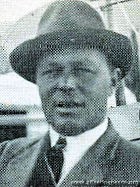
photo: 1930
One of the most experienced flying-boat pilots in the country: 3,000 hours by 1931.
RNAS during WWI, then flew in and around the Mediterranean and the Far East; spent 18 months as honorary instructor to the Singapore Flying Club.
Later an Air Vice Marshall.
-
Crossley, Fidelia Josephine
Miss Fidelia Josephine Crossley
 in 1930, aged 25
in 1930, aged 25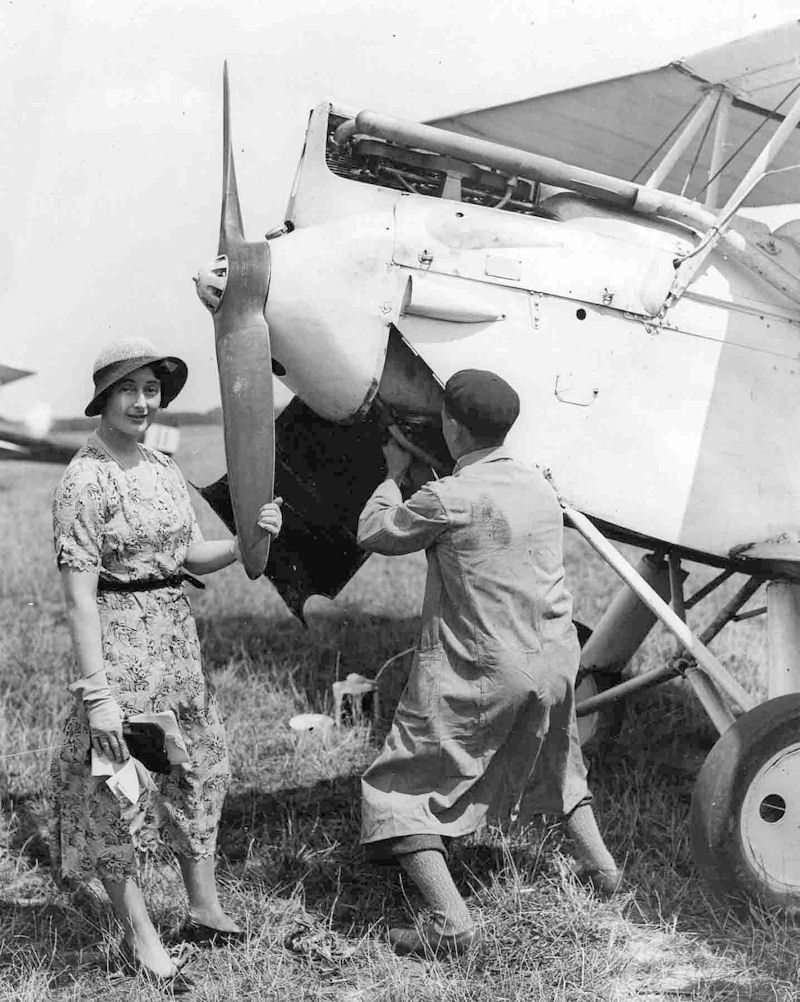
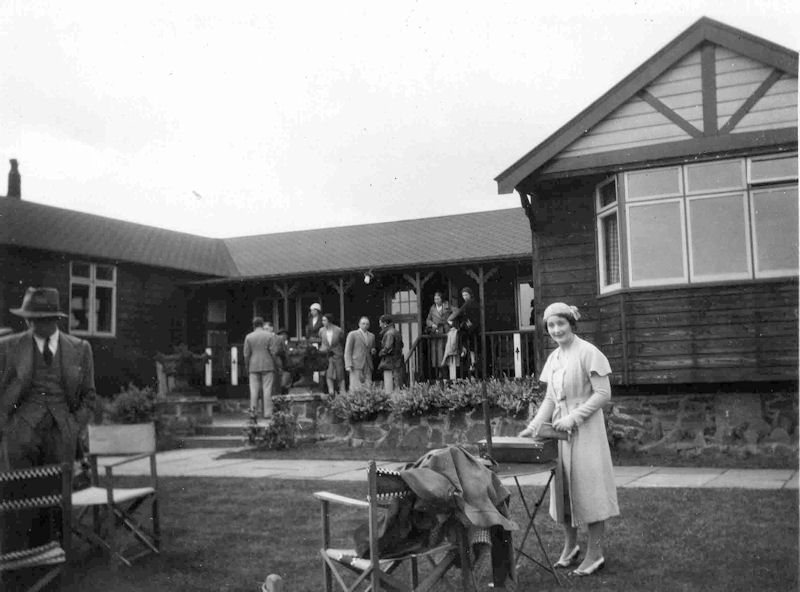
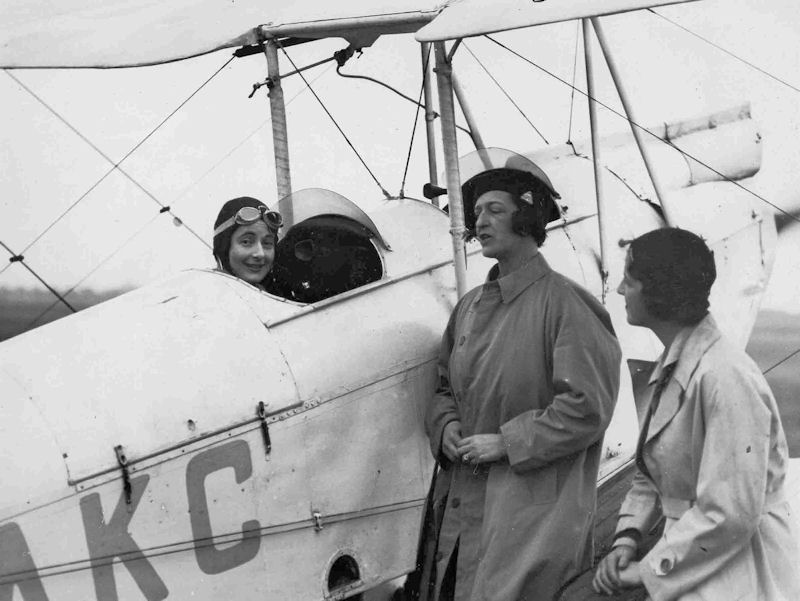
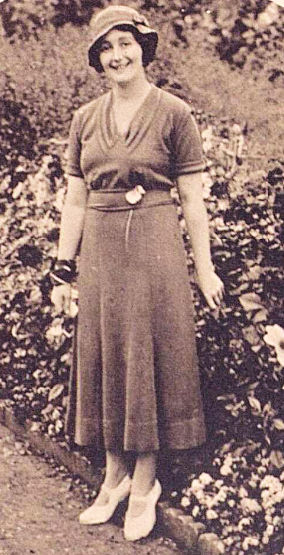 At Combermere Abbey in 1932
At Combermere Abbey in 1932'Delia', born 1st June, 1905, the daughter of Sir Kenneth Irwin, 2nd Baronet Crossley, Chairman of the Crossley Car and Engineering companies in Manchester.
In 1919, the Crossley family moved to Combermere Abbey, Whitchurch, Shropshire and her father held the offices of High Sheriff and Justice of the Peace for Cheshire. These days, although it continues in private ownership, Combermere Abbey ‘welcomes visitors in groups or on specific days by appointment’. It has been described as ‘one of the most romantic places in Europe’ .
Gained her pilot’s licence in 1930. She only competed in the King’s Cup once - in 1931, when she was the only woman competitor to finish, a gallant 20th out of the 21 finishers (another 20 dropped out on the way, don't forget).
August 1931 found her in Dublin; "Among the visitors was one who deserved especial mention, and that was the intrepid Miss Crossley, who put up such a fine show in the recent King's Cup race. She flew the long way round, and is now continuing to tour the country."
In 1932, she visited India, where "we hear she has been doing a considerable amount of flying." In fact, she competed in the Viceroy Cup (India's version of the King's Cup) with 5 other English pilots and 6 from India.
She also competed in several other races and gatherings, e.g.
- Ladies event at Reading (May, 1931) - the other competitors were Amy Johnson, Pauline Gower, Dorothy Spicer, Gabrielle Burr (Patterson), Susan Slade, and Winifred Spooner - a historic gathering indeed.

- London-Newcastle, August 1932, in Comper Swift G-ABUA; finished 11th of 18
- Yorkshire Tophy Race, September 1932 (not placed);
- Heston-Cardiff, October 1932, also in Comper Swift G-ABUA; finished 3rd of 9
- the second 'Bienvenue Aerienne' in France (July 1934)

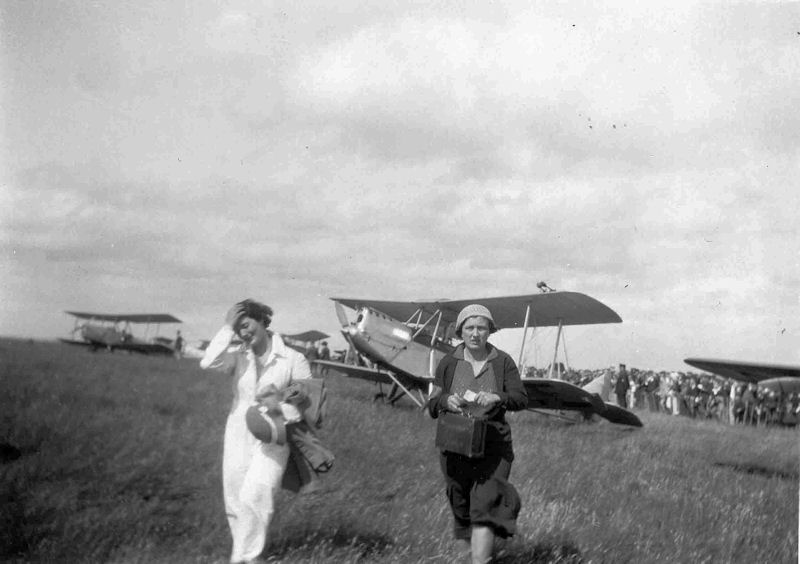
Delia with C C Grey (editor of 'The Aeroplane'), Mrs Grey, Connie Leathart and others.
She also entered her Comper Swift in the 1932 King's Cup Race, but withdrew before the start, and seems to have retired from air racing in 1935.
On the outbreak of WWII, Delia became an ambulance driver for the London County Council, but then applied for a job as a ferry pilot for the Air Transport Auxiliary (ATA).
Air Transport Auxiliary in WWII
She married Geza O Schubert in September 1949.

Fidelia’s de Havilland D.H. 60G Gipsy Moth G-AAKC (seen here behind G-AACY) was first registered in July 1929, and she bought it from Malcolm Campbell Ltd, the Moth distributors for the UK. She eventually passed it to her father, and it was then sold in South Africa in 1937.
Her Comper Swift was first registered in February 1932 to J D M Gray, and she sold it to Arthur H Cook. It ended up in Indonesia.
... and there's a splendid page about 'Combermere's Pioneering Aviatrix Delia Crossley' here, written by the archivist at Combermere Abbey. -
Dawson, Wilfrid Leslie
Flt-Lt Wilfrid Leslie Dawson
 in 1917, when a 2nd Lieut., RFC, aged 27
in 1917, when a 2nd Lieut., RFC, aged 27b. 2 Apr 1890 in Huddersfield.
One of the first tranche of cadets at Cranwell when it opened in 1920.
Posted to RAF Staff College, Andover from January 1934, for 'Staff College Course No 12', then posted to 'Headquarters, Palestine and TransJordan' the following year.
Sqn Ldr from 1936. Married Elizabeth McIntyre, and their daughter was born in the Government Hospital Jerusalem in 1936, while he was also learning 'colloquial Arabic'.
216 (Bomber Transport) Sqn in Egypt in 1937, Wing Cmdr from 1939. In December 1939 he was one of 6 who survived the crash of an Imperial Airways airliner which crashed in the Mediterranean (5 died).
Grp Capt and CBE in 1943; Air Commodore and CB in 1945; Air Vice Marshall in 1948; Deputy Chief of Staff for Plans and Operations at NATO in 1953.
-
Douglas-Hamilton, Malcolm Avondale
Lord Malcolm Avondale Douglas-Hamilton OBE DFC  Flight, 1931
Flight, 1931b. 1909, the third of four brothers involved in aviation before, during and after WWII.
In 1932, Flight reported that "The amphibian service between the Clyde and Belfast was opened on August 13 when the new flying-boat Cloud of Iona made the first trip. The passengers included Lord and Lady Malcolm Douglas Hamilton."
He was granted a commission as a Flying Officer in June 1932, in 603 (City of Edinburgh) (Bomber) Squadron, Auxiliary Air Force.
Later a Wing Commander / Acting Group Captain during WWII who, with his second wife Natalie Winslow, founded the American Scottish Foundation after the war.
Died 1964 in a flying accident in Cameroon.
------------
Malcolm's younger brother David was killed in WWII when he crashed just short of RAF Benson to which he was returning from a mission in a Mosquito; his elder brother George married ATA pilot Audrey Sale-Barker (q.v.), and finally his eldest brother Douglas flew over Everest and later became an Air Commodore in the RAF - it was he who handed Rudolph Hess over to the authorities.
Here is Douglas, getting ready to go on Lady Houston's Everest expedition in 1933:

-
Edwards, Edward Cecil Theodore
F/O (later Flt-Lt, Sqn Ldr) Edward Cecil Theodore Edwards 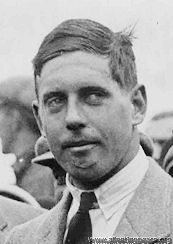 1931, aged 26
1931, aged 26Cecil, brother of Hugh. From Kensington, London. Sometimes known as "Sphinx".
M.A.(Oxon); rowing blue in 1925 and 1926 (when he was the "best man in the crew, as always"); the first member of the Oxford Air Squadron to qualify as a pilot.
Flew, with Winifred Spooner, a Desoutter in an attempt to reach Cape Town in 1930, but they had to ditch in the sea off Italy, and swim about a mile to shore.
Winner of the King's Cup in 1931; here is his "Competitor's Armband" from the race:

Apparently, after the race, "a triumphant Cecil 'Sphinx' Edwards was invited to Sir Robert MacAlpine's house to celebrate the win (Sir Robert had lent Sphinx his Bluebird aeroplane). On leaving the party, Sir Robert grabbed the trophy, said "Well done Edwards" and that is the last that Sphinx or the family would ever see of the trophy. It is now awarded at Henley as The Prince of Wales Challenge Cup after mysteriously being donated to Henley by an antique shop owner."
with many thanks to Gavin Jamieson, who found the armband among his family's archives
Killed in WWII: 31st August 1940, when a Wing Commander (pilot) 53 Sqn RAF; buried in Rotterdam, Holland.
-
Fawcett, Thomas Constantine
Mr Thomas Constantine Fawcett 
photo: 1930, aged 32
A Engineer from County Durham
-
Franklyn, Arthur
Mr Arthur Franklyn 
photo: 1930, aged 23
A speedway racer in Manchester in 1929-31 (see also Jack Ormston) who was briefly the 'King of the White City'. Retired from speedway and took up a commission with the RAF.
d.1983 in Ipswich, Suffolk
-
Gibbons, Frank George
Flt-Lt Frank George Gibbons  1918, when a 2nd Liet, aged 19
1918, when a 2nd Liet, aged 19 1930, aged 31
1930, aged 31from Peterborough; WWI air ace (14 victories); killed in May 1932, flying into a tree during the Morning Post (Heston) air race.
1932: "The tragic loss of Fit. Lt. Frank George Gibbons during the race organised by the Morning Post on Saturday, May 21, was one which came as a shock to his many friends. It would appear fairly certain that his death was due to his colliding with a tree while looking at his maps inside the cockpit, and was in no way caused by any defect in the "Spartan" three-seater he was flying at the time. He was a particularly likeable character, besides being an outstanding expert as a pilot.
He was one of those people about whom one never heard any gossip, and his likeable character is shown by the fact that although he was the best of companions at the kind of party which usually finishes an air meeting, he was equally at home spending an afternoon playing with young children.
He first joined the R.F.C. in June, 1917, as an air mechanic (cadet), and gained his commission in November of the same year. He was gazetted as a Fit. Lt. on June 1, 1926, and won the D.F.C. for services in the field.
Not only was he a very fine pilot of land aircraft, but also of flying boats. On January 5, 1931, he went to Calshot, and from there he was posted to No. 204 Flying Boat Squadron at Mountbatten, Plymouth, of which he was a member at the time of his death.
He was a brilliant navigator, and this form of race was one in which he was particularly interested. It is perhaps, therefore, some consolation to feel that if he himself could have had the choice, he would have undoubtedly have chosen to die when flying "flat-out" during such a race, in the manner he did.
The funeral took place at Ipswich on Wednesday, May 25. He was 33 years of age and unmarried."
-
Gillan, John Woodburn
F/O John Woodburn Gillan DFC and bar, AFC 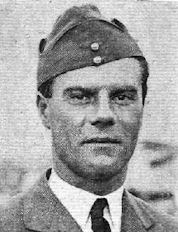
b c1907. From Edinburgh.
Established a world's land plane record in an RAF Hawker Hurricane on February 10, 1938; flying "blind", he covered the 327 miles from Edinburgh to London in 48 minutes, an average speed of 408.75mph. This feat earned him the nickname of 'Downwind Gillan'.
AFC in January 1939 as Sqn Ldr.
Killed in WWII: 29th August 1941, when a Wing Commander (pilot) RAF; buried Dunkirk.
-
Gough, Fred
Mr Fred Gough 
photo: 1927, aged 28
From Norwich, a 'cardboard and container manufacturer'. Joined the RFC as a private in 1916.
Manager of the Norfolk and Norwich Aero Club from 1927.
-
Grierson, John
Mr John Grierson Having joined the RAF but then regretted it, John tried to resign in 1931. However, his resignation being refused, he smuggled himself from where he was stationed in India into his D.H.60G Moth 'Rouge et Noir' (which he had bought from Glen Kidston, and which was painted red one side and - you guessed it - black the other), and flew home, making long hops to avoid R.A.F. aerodromes. "The business was settled in the end without a courtmartial, though not without a period of open arrest".
Next came a solo flight of 9,000 miles round Russia, and then an abortive attempt on the Arctic air route in Rouge et Noir equipped as a seaplane; a nose-over into a choppy sea at Reykjavik put paid to the attempt.
Rebuilt, and fitted with wheels and ski equipment, the little Moth finally carried Mr. Grierson round Eastern Europe in mid-winter.
Then, in 1934, he made a successful westbound Atlantic flight via Iceland in his de Havilland Fox Moth 'Robert Bruce'.
Transferred to Hawker and then Gloster as a test pilot; he was one of four pilots to fly Britain's first jet aircraft, the Gloster/ Whittle E.28/39.
Wing commander after WWII, then a Member of the Council of the Royal Geographical Society.
d. 21 May 1977 in Washington DC, aged 68. He was addressing a symposium at the Smithsonian's Air and Space Museum to mark the 50th anniversary of Lindbergh's transatlantic flight when he was taken ill; he died a few hours later in hospital.
-
Guest, Diana
Miss Diana Guest
Royal Aero Club Certificate 8756 (27 Aug 1929)

photo: 1929, aged 20

Frederick's daughter; later sculptress Diana Guest Manning. [Mr Manning was one of her 3 husbands].
"I was born and brought up in the country in England. My parents, Amy Phipps and Frederick Guest, met in India and married a year later in London. They settled in a beautiful Queen Anne house near Oakham named Burley on the Hill".

"AN ATALANTA OF THE AIR - MISS DIANA GUEST, CAPTAIN "FREDDIE" GUEST'S PILOT DAUGHTER.
Miss Diana Guest, the young daughter of Captain the Hon. Freddie Guest, P.C., C.B.E., D.S.O., etc., Chairman of the National Flying Services, was born in 1909, and recently made her debut in society. She has also just made her debut in the air, and took her pilot's A certificate recently. She and her father had their flying lessons at the same time, and took their respective tickets simultaneously for although Captain Guest, who was born in 1875, has long been interested in flying, and was Secretary of State for Air from 1921-1922, he was not the holder of a pilot's A certificate. "
The Sketch, 1929
In 1981 "Miss Guest, who divides her time between Paris and Palm Beach, Fla., and whose works have been exhibited in museums around the world, has donated 27 pieces of her sculpture to Old Westbury Gardens".
Diana owned:
- 1929 Hawker Tomtit G-AALL, then
- 1930 DH.80A Puss Moth, G-AAZP, which later became SU-AAC in Egypt and was impressed in WWII as HL537.
d. 1994
Page 1 of 3




